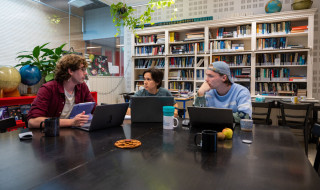Plekkie: better utilisation of buildings thanks to Internet of Things
In short
- What: Optimisation of space scarcity is possible if you have insight into occupancy rates. With this project, we aim to offer users insight into the occupancy and availability of spaces at a location based on IoT sensor data.
- Challenge: How can we help staff and students find a free and suitable space at their institution?
- Solution: Collecting IoT sensor data which is then presented insightfully via the Plekkie app so that users can easily navigate to a free and suitable space.
Students and staff want to make the best use of their institution's facilities. Institutions themselves also have an interest in making the best use of spaces. How can IoT sensors help with this? With that question, we started the proof of concept Plekkie.
Plekkie
Together with Hanzehogeschool Groningen, SURF started a proof of concept to investigate how Internet of Things (IoT) sensors can help students find the plekkie they need at that moment. Here, we combined all kinds of different data: from sensors, facilities, room sizes and availability. All the data comes together in one app, where in students and staff could specify exactly what they were looking for: a space to confer, workshop, study or just chill.
Sensor technology and IoT
The app uses data transmitted by motion sensors in classrooms and other rooms. This makes Plekkie a good example of how sensor technology and the Internet of Things can be used.
IoT helps make best use of spaces
For educational institutions with several buildings and many different rooms, it is often a huge task to schedule their use at the beginning of the academic year. And almost always the actual use turns out to be slightly different. By monitoring rooms in real time, it is immediately clear whether rooms are occupied or available.
The pilot was conducted in the Hanzehogeschool's Digital Society Hub innovation workplace. There, rooms were fitted with sensors measuring temperature, CO2, movement and sometimes sound. This is to ultimately gain insight into the use, traffic flow and occupancy of locations. For Plekkie, only movement data is used.

Plekkie helps students easily find a free space - cleverly arranged with IoT sensors.
How does Plekkie work?
Students or staff looking for an available space enter the app, indicating the purpose and how many people they are with. The app then shows which suitable rooms are available in real time. A claimed space automatically disappears from the offer for 5 minutes. So it is not about booking, but ad hoc matching of supply and demand.
When movement is detected in the space, a pop-up appears to confirm your presence. It may also be that someone else is already using the room, after which a new space can be searched.
After use, qualitative feedback is requested: how suitable was the room and were the right facilities available?
The use of Plekkie is of course well secured. Students and staff log in via SURFconext and only an identifier is stored. The Plekkie app was built using the privacy-by-design principle.
On to the future
Developed as a proof of concept, Plekkie has become a well-functioning demo version. There are ideas for expansion and such as user location tracking and a dashboard for facility managers. Whether this showcase app will be developed further is not yet certain. This depends, among other things, on interest from institutions and developments in the market.
Sensor technology and the Internet of Things offer endless possibilities to manage buildings more intelligently, efficiently and cheaply. The data collected can be used, for example, for building design, visitor flow management, heating, lighting, security and access management.